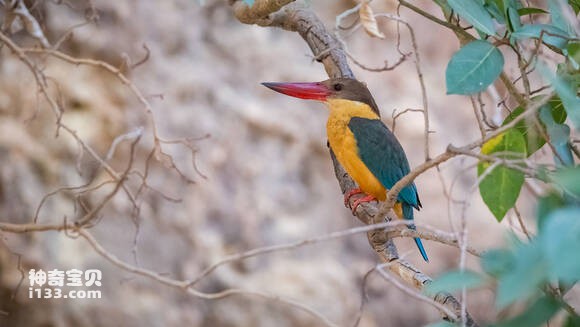Pelargopsis capensis
IUCN
LCBasic Information
Scientific classification
- name:Pelargopsis capensis
- Scientific Name:Fish-catching man, stork-billed kingfisher,Pelargopsis capensis,Stork-billed Kingfisher
- Outline:Climbing birds
- Family:O.Alcedomorpha S.Alcedo F.Alcedo G.Alcedo
Vital signs
- length:35-37cm
- Weight:140-200g
- lifetime:No verification information
Feature
It is large in size, with a huge, flattened beak, like a stork's beak, red in color, and with nasal grooves on both sides of the beak.
Distribution and Habitat
Origin: Bangladesh, Brunei Darussalam, India, Indonesia, Lao People's Democratic Republic, Malaysia, Myanmar, Nepal, Philippines, Singapore, Sri Lanka and Thailand.
Wandering: China.
It mainly lives on the banks of streams and river valleys in evergreen broad-leaved forests below 1,200 meters above sea level. It lives in waters such as small rivers, streams, lakes and irrigation canals with clear and slow-flowing water in shrubs or sparse forests.
Appearance
The mouth is huge, thick, long and pointed, shaped like a stork's mouth, and is red. The forehead, top of the head, and occiput are grey-brown, and there is a broad ocher-brown collar on the back of the neck. The back is sky blue, and the waist, upper tail coverts and tail feathers are blue. The surface of the upper back, shoulders and wings is dark iron blue, with slight green tinges on the upper back. The primary flight feathers are black, the feather edges are lighter in color, and the secondary flight feathers are dark blue. The entire lower body including the chin, throat, chest, abdomen, underwing coverts and axillary feathers are ocher brown, with the chin and throat being lighter in color.
The iris is brown and the legs are red. The mouth is red and flat on the sides; there are nasal grooves on both sides of the mouth peak; the tail is longer than the mouth; the wings are short and round.
Size measurement: weight 140-200 grams, body length 350-370 mm, mouth peak 72-8
Details
Stork-billed Kingfisher is a medium-sized bird with 13 subspecies.

The similar species of Stork-billed Kingfisher, the Blue Kingfisher, is smaller in size and bill, with a black head; the chin, throat, upper chest and collar are white, and the wing coverts are black. When flying, there are white wing spots on the wings, which are very obvious.

Stork-billed Emerald is solitary and often acts alone. It usually rests upright on low branches, reeds or rocks near the water, waiting for fishing machines in the water to prey on fish and shrimp. Like other kingfishers, it can maintain excellent vision for fishing in the water after entering the water, because after their eyes enter the water, they can quickly adjust the visual contrast caused by light in the water. Therefore, the kingfisher's fishing skills are almost always accurate.

The stork-billed kingfisher mainly feeds on fish, shrimp, crustaceans and aquatic insects, and also eats small invertebrates and vertebrates such as lizards, rodents, frogs, snakes, locusts and grasshoppers. Call: Bright and sharp "wiak wiak" like laughter, and a rough howl when warning.

The breeding season of the stork-billed emerald is from March to June. It nests in rock caves on the river bank, digging its own holes. The caves are tunnel-shaped, and the ends of the caves are expanded into nests. These caves are generally not covered with bedding. The eggs are laid directly on the ground of the nest. Sometimes they also nest in tree holes by the river. Each nest lays 3-5 eggs, but most of them are 4-5 eggs. The eggs are 34-38 mm × 30-32 mm in size. The male and female parents take turns incubating the eggs. The chicks are late-maturing.

Listed in the "Red List of Threatened Species of the World Conservation Union" (IUCN) 2016 ver 3.1-Least Concern (LC).
Listed in China's "National Key Protected Wildlife List" (February 5, 2021) Level 2.
Protect wildlife and eliminate game.
Maintaining ecological balance is everyone's responsibility!








